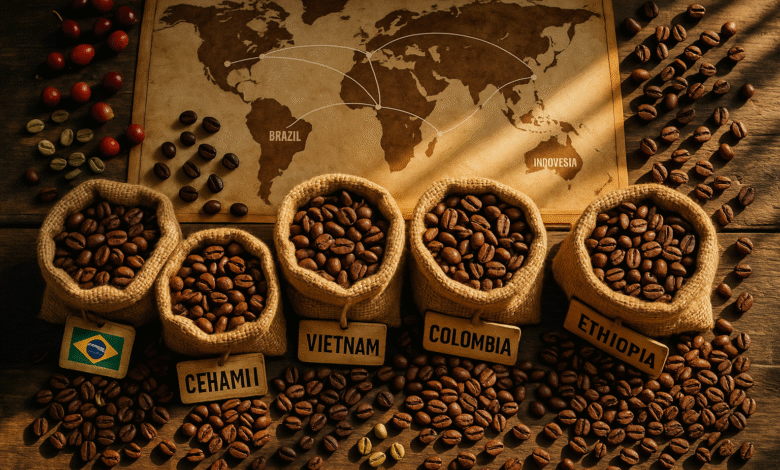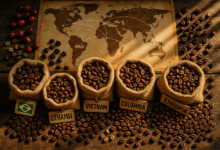Top 10 Coffee Exporting Countries 2025 (Updated List)
Discover the top coffee exporting countries in 2025. Brazil, Vietnam, and Colombia lead global coffee exports with unique beans and production methods shaping the industry.

Your morning coffee travels thousands of miles before reaching your cup. Behind every sip lies a complex network of coffee exporting countries that fuel a multi-billion dollar global industry. The international coffee trade reached $51.2 billion in 2024, representing a massive 66% increase since 2020. With over 9.24 million tons of coffee shipped worldwide, understanding which nations dominate this market reveals fascinating insights about agriculture, economics, and the beverage that drives millions of people each day.
The global coffee market continues evolving rapidly, with traditional powerhouses maintaining their positions while emerging producers challenge the status quo. From the sun-drenched plantations of Brazil to the mountainous regions of Ethiopia, each coffee producing country brings distinct flavors, farming techniques, and cultural traditions to the table. Climate conditions, altitude, soil quality, and processing methods all contribute to what makes coffee from one region different from another.
This article explores the top coffee exporting countries that dominate the 2025 landscape. Whether you’re a coffee enthusiast curious about your brew’s origins, a business professional tracking commodity markets, or simply someone who appreciates their daily caffeine fix, understanding these major players provides valuable context about one of the world’s most traded commodities. Let’s examine which nations lead the pack and what makes their coffee beans special.
EXPLORE THE CONTENTS
Understanding the Global Coffee Export Landscape
The coffee industry operates within what experts call the Bean Belt, a geographic band between 25° North and 30° South latitude where conditions are ideal for coffee cultivation. This region encompasses parts of Central and South America, Africa, Southeast Asia, and select Pacific islands. Not every country that grows coffee exports it, and interestingly, some of the biggest exporters by value don’t actually grow any coffee at all.
Two main species dominate commercial production: Arabica coffee and Robusta coffee. Arabica accounts for about 60-70% of global production and is prized for its smooth, complex flavor profiles. Robusta, hardier and higher in caffeine, thrives at lower altitudes and produces a stronger, more bitter taste. The distinction matters because it affects pricing, market positioning, and which countries excel in each category.
The coffee supply chain involves multiple stages from cultivation to export. Farmers harvest coffee cherries, which undergo processing to extract the beans. These green coffee beans are then dried, sorted, graded, and packaged for export. Many producing countries ship green beans to importing nations where roasting and final processing occur. This explains why countries like Switzerland and Germany rank among top exporters by value despite growing minimal coffee domestically.
Brazil: The Undisputed King of Coffee Exports
Brazil has dominated global coffee production for over 150 years, and that reign shows no signs of ending. In 2024, Brazil exported 2.77 million tons of coffee, representing approximately 30% of worldwide coffee exports. The country’s export value reached $11.4 billion, far surpassing any competitor.
The secret to Brazil’s success lies in several factors. The southeastern states of Minas Gerais, São Paulo, and Paraná provide ideal growing conditions with their rich soil, favorable climate, and varied altitudes. Brazil produces both Arabica and Robusta beans, though Arabica dominates with varieties like Mundo Novo, Catuaí, and Bourbon thriving across millions of acres.
Brazilian coffee farming has embraced technology and efficiency at scale. Large plantations utilize mechanical harvesting, drone monitoring, and advanced processing facilities. The harvest season runs from May to September, with both selective picking and strip picking methods employed depending on terrain and farm size. Processing methods include natural (dry) processing, where cherries dry whole, and pulped natural methods.
What distinguishes Brazilian coffee? The beans typically offer chocolate and nutty notes with mild acidity and a smooth, full body. While specialty coffee enthusiasts sometimes criticize mass-produced Brazilian beans as lacking complexity, the country also produces exceptional specialty grades that command premium prices. Brazil’s infrastructure, from roads to ports, ensures efficient global distribution to major markets including the United States, Germany, Italy, Japan, and Belgium.
Vietnam: The Robusta Powerhouse
Vietnam claims the number two spot among coffee exporting countries, shipping 1.95 million metric tons annually. This Southeast Asian nation’s rise in the coffee world is remarkable considering commercial production only began seriously in the 1980s under government initiatives to diversify agriculture.
The central highlands region, particularly Đắk Lắk, Lâm Đồng, and Gia Lai provinces, serves as Vietnam’s coffee heartland. Robusta coffee accounts for roughly 95% of Vietnamese production, making the country the world’s leading Robusta supplier. The beans thrive in Vietnam’s climate and require less intensive care than Arabica, allowing smaller farmers to participate profitably.
Vietnamese coffee culture differs markedly from Western traditions. The strong, bold flavors are typically served with sweetened condensed milk in small portions, creating the distinctive Vietnamese iced coffee (cà phê sữa đá) beloved by locals and tourists alike. For export, Vietnamese beans predominantly supply instant coffee manufacturers, espresso blends, and commercial-grade products where Robusta’s intensity and affordability are assets.
Export value for Vietnam reached approximately $4 billion in recent years, ranking it fifth globally by monetary value despite its second-place position in volume. This reflects Robusta’s generally lower price point compared to Arabica. Major export destinations include Germany, the United States, Japan, Italy, and Spain, according to World’s Top Exports.
Climate challenges and market volatility affect Vietnamese producers. Droughts and irregular rainfall patterns linked to climate change have impacted recent harvests. Nevertheless, Vietnam continues investing in quality improvements, experimenting with Arabica cultivation in select regions, and exploring specialty coffee niches to capture higher-value markets.
Colombia: Premium Arabica Excellence
Colombia ranks third among the largest coffee exporting countries, exporting approximately 12.9 million 60-kilogram bags in 2024. Unlike Brazil and Vietnam, Colombia focuses almost exclusively on Arabica coffee, building a reputation for exceptional quality that commands premium prices internationally.
The Colombian Coffee Growers Federation (Federación Nacional de Cafeteros) has successfully branded Colombian coffee through the Juan Valdez character and Protected Geographical Indication status. This marketing prowess, combined with genuine quality, allows Colombian beans to sell at higher rates than many competitors. Colombian Arabica consistently fetches top prices on commodity markets.
Geography plays a crucial role in Colombian coffee’s character. The Andes Mountains provide ideal growing conditions with high altitudes (1,200 to 1,800 meters), volcanic soil, consistent rainfall, and moderate temperatures. Major growing regions include Antioquia, Huila, Nariño, Tolima, and Cauca, each imparting subtle regional characteristics. Colombian coffee typically presents bright acidity, medium body, and notes ranging from caramel and chocolate to fruity and floral, depending on origin and processing.
Small-scale farmers dominate Colombian production, with over 500,000 coffee-growing families working relatively small plots. This structure necessitates robust cooperative systems and support networks. The harvest occurs twice yearly due to Colombia’s equatorial position, providing two distinct harvest seasons that help stabilize supply and income.
Colombia’s export value exceeded $3 billion in 2024, reflecting both volume and quality premiums. Primary markets include the United States, Germany, Japan, Belgium, and South Korea. The Colombian coffee industry faces pressures from climate change, coffee leaf rust disease, and competition from lower-cost producers, but continues adapting through disease-resistant varieties, diversification strategies, and emphasis on specialty and sustainable coffee segments.
Also Read: The Science of Coffee: How to Brew the Perfect Cup
Indonesia: The Rising Asian Giant
Indonesia has emerged as a significant player in the global coffee trade, ranking fourth or fifth depending on the metric used. The country exported over 650,000 tons in 2024, with export values showing a remarkable 76% increase from the previous year.
The Indonesian archipelago’s diverse geography creates varied coffee-growing microclimates across islands including Sumatra, Java, Sulawesi, and Bali. Each region produces beans with distinct characteristics. Sumatran coffee, particularly Mandheling and Gayo varieties, offers earthy, herbal notes with full body and low acidity. Java, historically significant in coffee’s global spread, produces smooth, bright beans. Sulawesi’s Toraja coffee presents complex, wine-like characteristics.
Indonesia grows both Arabica and Robusta, with Robusta comprising roughly 75% of production. The unique “wet-hulling” processing method used extensively in Indonesia (locally called Giling Basah) contributes to the distinctive flavor profile that coffee connoisseurs either love or find too earthy and unconventional.
Specialty coffee from Indonesia, including the controversial Kopi Luwak (civet coffee), attracts premium prices and international attention. While Kopi Luwak’s authenticity and ethics face scrutiny, it demonstrates Indonesia’s capacity to produce unique, high-value coffee products. More sustainably, Indonesian farmers increasingly focus on organic certification, fair trade practices, and specialty-grade production to capture higher market values.
Ethiopia: The Birthplace of Coffee
Ethiopia holds a special place in coffee history as the crop’s birthplace. Legend tells of Kaldi the goat herder discovering coffee’s energizing properties in the Ethiopian highlands centuries ago. Today, Ethiopia remains Africa’s largest coffee producer and a top coffee exporting country, shipping approximately 240,000 to 270,000 metric tons annually.
Ethiopian coffee is exclusively Arabica, with incredible genetic diversity due to the crop’s native status. Wild coffee still grows in Ethiopian forests, and farmers cultivate numerous indigenous varieties (often called “heirloom” varieties) found nowhere else. This diversity creates remarkable flavor complexity ranging from bright, citrusy, and tea-like to bold, wine-like, and blueberry-noted profiles.
Three main growing regions define Ethiopian coffee character:
- Yirgacheffe: Light-bodied with floral, citrus, and tea-like notes
- Sidamo: Balanced with berry, chocolate, and wine-like characteristics
- Harrar: Full-bodied with fruity, wine-like, and sometimes fermented notes
Processing methods include washed, natural (dry), and increasingly, honey processing. Natural processed Ethiopian beans often exhibit intense fruit flavors that specialty coffee enthusiasts prize highly. The traditional Ethiopian coffee ceremony reflects coffee’s cultural importance, involving roasting, grinding, and brewing in an elaborate ritual shared with family and guests.
Despite its heritage and quality, Ethiopia faces challenges maximizing export value. Infrastructure limitations, political instability, and fragmented smallholder production complicate supply chains. Nevertheless, Ethiopian coffee commands respect and premium prices in specialty markets, with export values exceeding $900 million annually according to Statista.
Other Major Coffee Exporters Shaping 2025
Several additional countries play crucial roles in the international coffee market:
Honduras emerged as Central America’s largest coffee producer, exporting approximately 5.3 million bags in 2024. High-altitude Arabica from regions like Copán and Montecillos offers sweet, fruity, balanced profiles. Government support for organic and fair-trade certifications strengthens Honduras’s position in ethical coffee segments. The country predominantly exports to the United States, given geographic proximity and strong trade relationships.
India brings unique offerings to global markets, producing both Arabica and Robusta. The famous Monsooned Malabar coffee undergoes a unique aging process where monsoon winds and moisture transform the beans’ characteristics, creating a distinctive low-acid, earthy, spicy profile. Indian coffee production exceeds 234,000 metric tons annually, with major growing regions in Karnataka, Kerala, and Tamil Nadu. India’s export value grew 51% in recent years, reflecting quality improvements and market expansion.
Uganda ranks among Africa’s top coffee producers, specializing primarily in Robusta coffee with over 209,000 metric tons produced annually. The country also cultivates Arabica in mountainous areas like Mount Elgon and the Rwenzori Mountains. Ugandan coffee shows rich, earthy flavors with chocolate and spice notes. Coffee remains crucial to Uganda’s economy, supporting millions of smallholder farmers and representing a significant export commodity.
Peru contributes approximately 4.35 million bags of high-quality Arabica grown in Andean regions. Peruvian coffee is known for mild flavors with cocoa and nutty notes. The country leads in organic coffee production, with cooperative-based farming and traceability initiatives appealing to socially conscious consumers. Peru primarily exports to the United States and European Union markets.
Mexico completes the top ten, shipping nearly 3.9 million bags annually. Arabica from Chiapas, Veracruz, and Oaxaca regions offers sweet, lightly acidic profiles popular in American coffee shops. Geographic proximity means over 60% of Mexican coffee exports go to the United States, making Mexico a strategic supplier to North American markets.
European Re-Exporters: Switzerland and Germany
Interestingly, two of the top five coffee exporters by value grow virtually no coffee domestically. Switzerland ranked second globally in export value at $3.6 billion in 2023, while Germany came third. How do non-producing countries achieve such rankings?
These nations import green coffee beans, roast and process them using advanced technology and expertise, then re-export finished products. Switzerland hosts major coffee companies and trading houses with sophisticated processing facilities. German roasters serve both massive domestic consumption and international markets. The value-added processing, quality control, and brand development justify premium pricing that exceeds raw bean values.
Italy, France, Belgium, and the Netherlands similarly rank among top exporters despite minimal domestic production. Their roles highlight how the coffee supply chain involves more than growing and harvesting. Roasting expertise, packaging, branding, and distribution networks create additional value that can exceed origin country revenues.
Factors Driving the Coffee Export Industry in 2025
Several trends and challenges shape the current coffee trade landscape:
Climate change poses the most significant long-term threat. Rising temperatures, irregular rainfall, increased pest pressure, and extreme weather events all impact coffee production. Studies suggest suitable land for Arabica cultivation could decrease substantially by 2050, potentially reshaping which countries can compete effectively.
Sustainability and ethical sourcing have moved from niche concerns to mainstream requirements. Consumers increasingly demand transparency about environmental practices, farmer compensation, and supply chain ethics. Certifications like Fair Trade, Rainforest Alliance, and organic labels influence purchasing decisions. Producing countries investing in sustainable practices and quality improvements position themselves favorably for specialty markets.
Specialty coffee growth continues accelerating. While commercial-grade coffee still dominates volume, specialty coffee commands significant premiums and influences overall market dynamics. Countries emphasizing quality, unique processing methods, and origin transparency capture higher values per pound even with smaller volumes.
Market volatility affects both producers and exporters. Coffee prices fluctuate based on weather forecasts, harvest estimates, currency movements, and geopolitical events. The 2024 average export price of $5,536 per ton represented a 60% increase from 2020 levels but also creates uncertainty for farmers and buyers planning annual operations.
Emerging consumption markets in Asia, particularly China and South Korea, are diversifying demand patterns. Traditional coffee-drinking cultures in Europe and North America remain crucial, but Asian market growth creates new opportunities and shifts in global trade flows.
The Economic Impact of Coffee Exports
Coffee exports represent crucial income sources for dozens of developing nations where the crop provides livelihoods for millions of smallholder farmers and plantation workers. For countries like Honduras, Ethiopia, Uganda, and Nicaragua, coffee ranks among the top agricultural exports, directly impacting GDP, employment, and foreign currency reserves.
However, the value distribution across the coffee supply chain remains controversial. Studies indicate farmers often receive only 10-20% of the final retail price consumers pay. This disparity has fueled movements for fair trade practices, direct trade relationships, and cooperative models that attempt to shift more value to origin countries and producers.
The top 15 coffee exporters accounted for 80.9% of global export value in 2024. This concentration means production disruptions in major suppliers like Brazil or Vietnam can significantly impact worldwide prices and availability. Weather events, political instability, or disease outbreaks in key regions reverberate through global markets rapidly.
Future Outlook for Coffee Exporting Countries
The coffee industry faces a critical juncture as 2025 progresses. Supply constraints from weather impacts in 2024, low inventories, and lagging production recovery suggest tight global supplies and elevated prices will persist. This benefits efficient producers who maintain consistent quality and volume but challenges smaller players unable to weather market volatility.
Success in 2025 and beyond depends on more than volume production. Differentiation through specialty offerings, climate resilience, sustainable practices, and origin traceability increasingly determine which countries and regions thrive. Brazilian efficiency and scale, Vietnamese cost competitiveness, Colombian quality branding, Ethiopian unique varieties, and Indonesian specialty positioning all represent different strategic approaches to market challenges.
Investment in infrastructure, farmer support systems, disease-resistant varieties, and climate adaptation strategies will separate tomorrow’s leaders from those unable to compete. The countries that help their farmers access information, technology, and fair markets while protecting environmental resources and ensuring social equity position themselves best for long-term success in the evolving global coffee market.
Conclusion
The top coffee exporting countries in 2025 represent a diverse group of nations united by their contribution to the world’s favorite beverage. Brazil’s unmatched volume, Vietnam’s Robusta dominance, Colombia’s premium Arabica, Indonesia’s exotic varieties, and Ethiopia’s historical significance each play vital roles in meeting global demand for over 9 million tons of coffee annually.
As climate challenges intensify, consumer preferences evolve, and new markets emerge, these producing nations must adapt while maintaining the quality and sustainability that coffee lovers worldwide depend on every morning.
Understanding where your coffee originates connects you to complex global systems involving millions of farmers, vast agricultural landscapes, and intricate trade networks that literally fuel our daily lives. The future of coffee depends on supporting these coffee producing countries as they navigate unprecedented challenges while continuing to deliver the beans that start billions of days worldwide.







